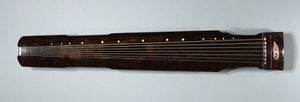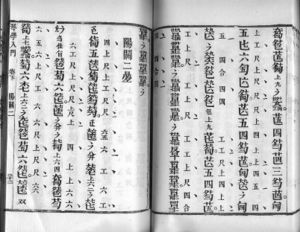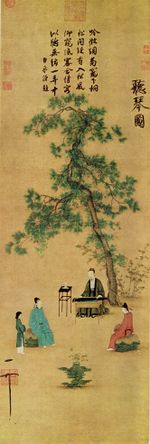گوتشين (آلة موسيقية)
| گوتشين | |||||||||||||||||||||||||||
|---|---|---|---|---|---|---|---|---|---|---|---|---|---|---|---|---|---|---|---|---|---|---|---|---|---|---|---|
 | |||||||||||||||||||||||||||
| Chinese name | |||||||||||||||||||||||||||
| الصينية | 古琴 | ||||||||||||||||||||||||||
| المعنى الحرفي | "ancient zither" | ||||||||||||||||||||||||||
| |||||||||||||||||||||||||||
| Japanese name | |||||||||||||||||||||||||||
| كانجي | 古琴 | ||||||||||||||||||||||||||
| هيراگانا | こきん | ||||||||||||||||||||||||||
| |||||||||||||||||||||||||||
گوچين أو قو تشين ([kùtɕʰǐn] (![]() استمع); صينية: 古琴�؛ إنگليزية: guqin) هي آلة وترية نقرية صينية قديمة يرجع تاريخها إلى أسرة تشو الملكية قبل أكثر من ثلاثة آلاف سنة. وكان يسميها الصينيون القدماء ب"تشين" أو "ياو تشين".
استمع); صينية: 古琴�؛ إنگليزية: guqin) هي آلة وترية نقرية صينية قديمة يرجع تاريخها إلى أسرة تشو الملكية قبل أكثر من ثلاثة آلاف سنة. وكان يسميها الصينيون القدماء ب"تشين" أو "ياو تشين".
شكل آلة قو تشين جميل دقيق الصنع، وصوتها عذب جلي ورقيق متغير. اهتمّ الصينيون القدماء بفنون عزفها اهتماما كبيرا، حيث كانوا يستحمون ويغيرون ملابسهم ويشعلون البخور قبل العزف، ثم يجلسون القرفصاء ويضعون الآلة على أفخاذهم أو منضدة خاصة للعزف. وينقرون الأوتار بأيديهم اليسرى لاخراج الصوت ويضغطون على الأوتار بأيديهم اليمنى لإنتاج الأنغام.
. . . . . . . . . . . . . . . . . . . . . . . . . . . . . . . . . . . . . . . . . . . . . . . . . . . . . . . . . . . . . . . . . . . . . . . . . . . . . . . . . . . . . . . . . . . . . . . . . . . . . . . . . . . . . . . . . . . . . . . . . . . . . . . . . . . . . . . . . . . . . . . . . . . . . . . . . . . . . . . . . . . . . . . .
التاريخ

وارتبط الأدباء القدماء الصينيون[1] بموسيقى آلة قو تشين ارتباطا وثيقا. أوضحت العديد من الوثائق التاريخية أن الأدباء القدماء الصينيين ظلوا مشتركين رئيسيين في موسيقى آلة قو تشين، حيث ساهموا في إبداعها وعزفها وتقييمها ونشرها مساهمة عظيمة.
يحتاج صنع آلة قو تشين عالية، ويعتبر فنا خاصا. فكانت أسرتي تانگ وسونگ الملكيتين عصرا ذهبيا لصنع آلات قو تشين حيث ظهرت آلات قو تشين دقيقة الصنع وجميلة الصوت. ولكن قد ضاع فن صنع آلة قو تشين منذ سنوات، والآلات الباقية من الأسر الملكية السابقة معظمها صنعت من قبل العازفين أنفسهم، فتختلف تركيباتها ومقاييسها. وفي عشرات السنوات الأخيرة أعادت الصين فن صنع آلة قوتشين وأجرت تحسينها، مما جعل هذه الآلة الموسيقية الصينية القديمة مفعمة بالحيوية مرة آخرى.
لآلة قوتشين قوة التعبير عن مشاعر الإنسان مثل الفرحة والسعادة، والزعل والحزن، وأيضا تجيد هذه الآلة وصف المناظر الطبيعية. تتنوع أساليب العزف على آلة قوتشين مثل العزف المنفرد، والعزف الجماعي مع المزمار الصيني الخيزراني العمودي أي آلة شياو، والعزف المصاحب للأغاني القديمة. وحوالي نصف عدد من المقطوعات المعزوفة على آلة قو تشين الموجودة الآن مقطوعات مصاحبة للأغاني الصينية القديمة.
العازفون
التاريخيون
- Confucius: Philosopher, 551-479 BCE, associated with the piece Kongzi Duyi,[2] Weibian Sanjue[3] and Youlan.[4]
- Bo Ya: Qin player of the Spring and Autumn Period, associated with the piece Gao Shan.[5] and Liu Shui [6]
- Zhuang Zi: Daoist philosopher of the Warring States period, associated with the piece Zhuang Zhou Mengdie[7] and Shenhua Yin.[8]
- Qu Yuan (340-278 BCE): Poet of the Warring States period, associated with the piece Li Sao.[9]
- Cai Yong: Han musician, author of Qin Cao.[10]
- Cai Wenji: Cai Yong's daughter, associated with the piece Hujia Shiba-pai,[11] etc.
- Sima Xiangru: Han poet, 179-117 BCE.
- Zhuge Liang (181–234): Chinese military leader in the Three Kingdoms, one legend has him playing guqin calmly outside his fort while scaring off the enemy attackers.
- Xi Kang: One of the Seven Sages of the Bamboo Grove, musician and poet, writer of Qin Fu.[12]
- Li Bai: Tang poet, 701–762.
- Bai Juyi: Tang poet, 772–846.
- Song Huizong: Song emperor famous for his patronage of the arts, had a Wanqin Tang[13] ("10,000 Qin Hall") in his palace.
- Guo Chuwang: Patriot at the end of the Song Dynasty, composer of the piece Xiaoxiang Shuiyun.[14]
The classical collections such as Qin Shi, Qinshi Bu and Qinshi Xu include biographies of hundreds more players.[15]
Repertoire

آلات ذات صلة
The Japanese ichigenkin, a monochord zither, is believed to be derived from the qin. The qin handbook Lixing Yuanya (1618[16]) includes some melodies for a one-string qin, and the Wuzhi Zhai Qinpu contains a picture and description of such an instrument.[17] The modern ichigenkin apparently first appeared in Japan just after that time. However, the honkyoku[18] (standard repertoire) of the ichigenkin today most closely resembles that of the shamisen.
The Korean geomungo may also be related, albeit distantly. Korean literati wanted to play an instrument the way their Chinese counterparts played the qin. The repertoire was largely the geomungo parts for melodies played by the court orchestra.
تسجيلات
The recordings below were made in 2013.
- هل لديك مشاكل في تشغيل هذه الملفات؟ انظر مساعدة الوسائط.
| Yangguan Sandie 《陽關三疊》 "Three Refrains on the Yang Pass Theme" | |
| From the Qinxue Rumen 【琴學入門】 (1867) | |
| Zuiyu Changwan 《醉漁唱晚》 "Evening Song of the Drunken Fisherman" | |
| From the Tianwen Ge Qinpu 【天聞閣琴譜】 (1876) | |
انظر أيضاً
- Contemporary guqin players
- Guqin aesthetics
- Guqin construction
- Guqin playing technique
- Guqin schools
- Guqin tunings
- List of traditional Chinese musical instruments
- Qinpu
- Se
- Yayue
مراجع
- ^ معلومات عامة عن الصين: الباب الثالث والعشرين – الادوات الموسيقية
- ^ 《孔子讀易》
- ^ 《韋編三絕/韦编三绝》
- ^ 《幽蘭/幽兰》
- ^ 《高山》
- ^ 《流水》
- ^ 《莊周夢蝶》
- ^ 《神化引》
- ^ 《離騷》
- ^ 【琴操】
- ^ 《胡笳十八拍》
- ^ 【琴賦】
- ^ 『萬琴堂』
- ^ 《瀟湘水雲/潇湘水云》
- ^ Zhou, Zi'an. Wuzhi Zhai Qinpu 【五知齋琴譜】. Volume 1, folio 1, leaf <gold> 18-28.
- ^ 【理性元雅】
- ^ Zhou, Zi'an. Wuzhi Zhai Qinpu 【五知齋琴譜】. Volume 1, folio 2, leaf 10.
- ^ 〔本曲〕


